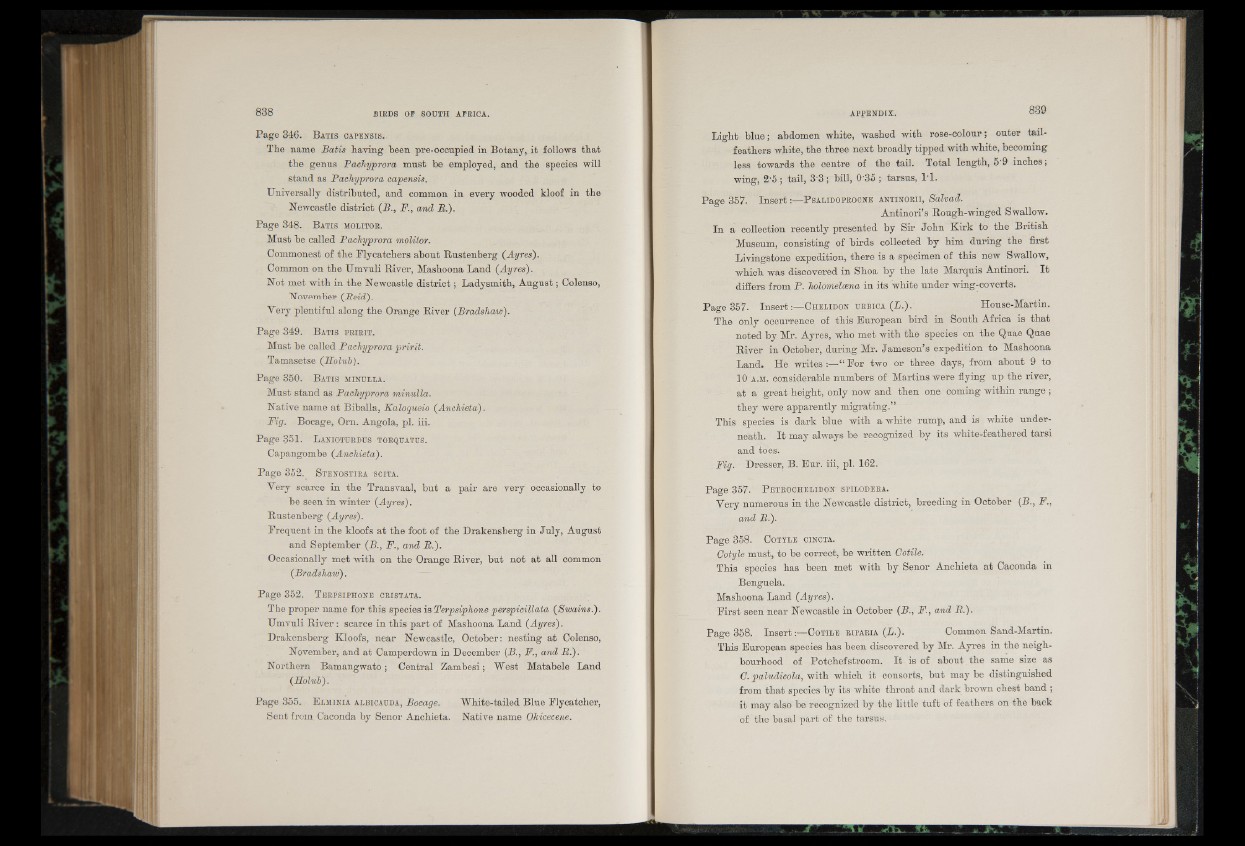
Page 346. B a t i s c ap e n sis.
The name Batis having been pre-occupied in Botany, it follows that
the genus Pachyprora must be employed, and the species will
stand as Pachyprora capensis.
Universally distributed, and common in every wooded kloof in the
Newcastle district (B., F., and B.).
Page 3 4 8 . B a t i s m o lito r .
Must be called Pachyprora molitor.
Commonest of the Flycatchers about Rustenberg (Ayres).
Common on the Umvuli River, Mashoona Land (Ayres).
Not met with in the Newcastle d is tric t; Ladysmith, August; Colenso,
November (Reid).
Very plentiful along the Orange River (Bradshaw).
Page 3 4 9 . B a ti s p r i r i t .
Must be called Pachyprora prir it.
Tamasetse (Holub).
Page 350. B a t i s m in u l l a .
Must stand as Pachyprora minulla.
Native name at Biballa, Kaloqueio (Anchieta).
Fig. Bocage, Om. Angola, pi. iii.
Page 351. L a n io tu r d u s t o r q u a tu s .
Capangombe (Anchieta).
Page 352. S t e n o s t i r a s c ita .
Very scarce in the Transvaal, but a pair are very occasionally to
be seen in winter (Ayres).
Rustenberg (Ayres).
Frequent in the kloofs at the foot of the Drakensberg in July, August
and September (B., F., and B.).
Occasionally met with on the Orange River, but not at all common
(Bradshaw).
Page 352. T e r p s ip h o n e c r i s t a t a .
The proper name for this species is Terpsiphone perspicillata (Swains.).
Umvuli River : scarce in this part of Mashoona Land (Ayres).
Drakensberg Kloofs, near Newcastle, October: nesting at Colenso,
November, and at Camperdown in December (B., F., and B.).
Northern Bamangwato; Central Zambesi; West Matabele Land
(Holub).
Page 355. E lm in ia a lb ic a u d a , Bocage. White-tailed Blue Flycatcher,
Sent from Caconda by Senor Anchieta. Native name Okicecene.
Light blue; abdomen white, washed with rose-colour; outer tail-
feathers white, the three next broadly tipped with white, becoming
less towards the centre of the tail. Total length, 5'9 inches;
wing, 2‘5 ; tail, 3'3 ; bill, 0'35 ; tarsus, l 'l .
Page 357. In s e rt:—P s a l id o p r o c n e a n t i n o r i i , Salvad.
Antinori’s Rough-winged Swallow.
In a collection recently presented by Sir John Kirk to the British
Museum, consisting of birds collected by him during the first
Livingstone expedition, there is a specimen of this new Swallow,
which was discovered in Shoa by the late Marquis Antinori. I t
differs from P. holomelcena in its white under wing-coverts.
Page 357. I n s e r t C h e iid o n u r b i c a (L .): House-Martin.
The only occurrence of this European bird in South Africa is that
noted by Mr. Ayres, who met with the species on the Quae Quae
River in October, during Mr. Jameson’s expedition to Mashoona
Land. He writes :—“ For two or three days, from about 9 to
10 a.m. considerable numbers of Martins were flying up the river,
a t a great height, only now and then one coming within range ;
they were apparently migrating.”
This species is dark blue with a white rump, and is white underneath.
I t may always be recognized by its white-feathered tarsi
and toes.
Fig. Dresser, B. Eur. iii, pi. 162.
Page 357. P e t r o c h e l i d o n s p i lo d e r a .
Very numerous in the Newcastle district, breeding in October (B., F.,
and B.).
Page 358. C o t t l e c in c ta .
Gotyle must, to be correct, be written Gotile.
This species has been met with by Senor Anchieta a t Caconda in
Benguela.
Mashoona Land (Ayres).
First seen near Newcastle in October (B., F., and B.).
Page 358. Insert:—C o t i l e r i p a r i a (L.). Common Sand-Martin.
This European species has been discovered by Mr. Ayres in the neighbourhood
of Potchefstroom. I t is of about the same size as
G. paludicola, with which it consorts, but may be distinguished
from th a t species by its white throat and dark brown chest band ;
it may also be recognized by the little tuft of feathers on the back
of the basal part of the tarsus.